Pralaya (MahaPralaya) information, meaning (Great tribulation) (Qayamat) (Hinduism) | When will Pralaya come?
Namaste friends, how are you doing today? Welcome to #BhagavanBhakthi website / blog.
Bhagavan Lord Sri Vishnu (Krishna) (Rama) blessings to you and your family!
In this website / blog, you will always learn about #Hinduism #Sanskrit language.
Also subscribe to my YouTube channel from this link #BhagavanBhakthi to view videos about #Hinduism #Sanskrit language.
Just before going to “Pralaya (MahaPralaya) information, meaning (Great tribulation) (Qayamat) (Hinduism) | When will Pralaya come?“, let us have some brief information.
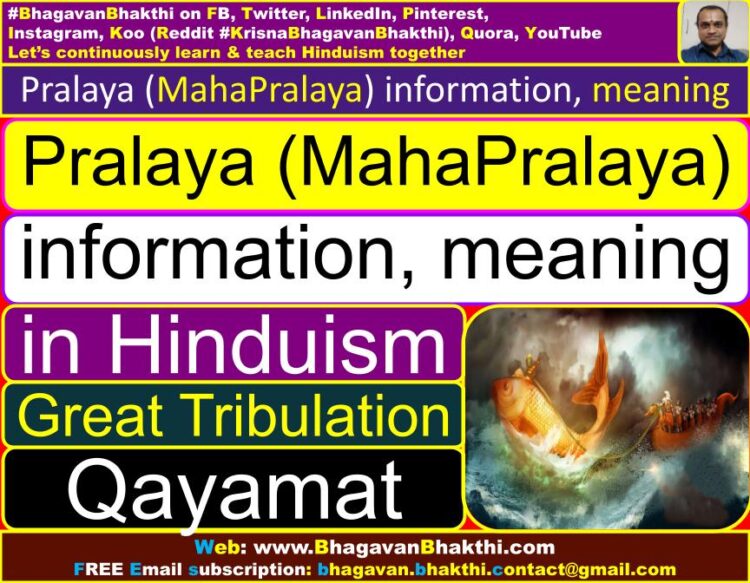
Many people always talk about the ‘Maha Pralaya’ or Great tribulation time or end of the world / universe or Qayamat time.
Does this really means that the world and universe will end and there will be no new creation in this world or universe. After this period nothing will be available.
Everything will be zero, empty etc.
What does the Great Sanatana Dharma (Hinduism) says about this.
After the Maha Pralaya, will this world / universe will end. If this universe end, then what will Lord Sri Vishnu do.
Let us understand this according to the Great Sanatana Dharma (Hinduism):
First let us understand what is the Pralaya or Maha Pralaya meaning is?
Pralaya means, “it is a process of ending (not destructing) anything and everything which was created by Lord Sri Brahma Deva”.
This includes the whole universe, living or non living things. Lord Sri Vishnu takes the form of Lord Sri Sankarshana and ends anything and everything.
This is similar to what we humans do when we need to clean our houses. We need to clean everything.
Then only we will be able to renovate our house (this is just a very small example and don’t compare with the Lord Sri Vishnu’s works).
What are the different types of Pralayas?
The different types of Pralayas are: Dina (day) Pralaya, Yuga Pralaya, Manvantara Pralaya and Maha Pralaya.
This is as per the Lord Sri Brahma Deva’s planet (that is Satya Loka) days and not as per the Prithvi Loka (earth’s revolution).
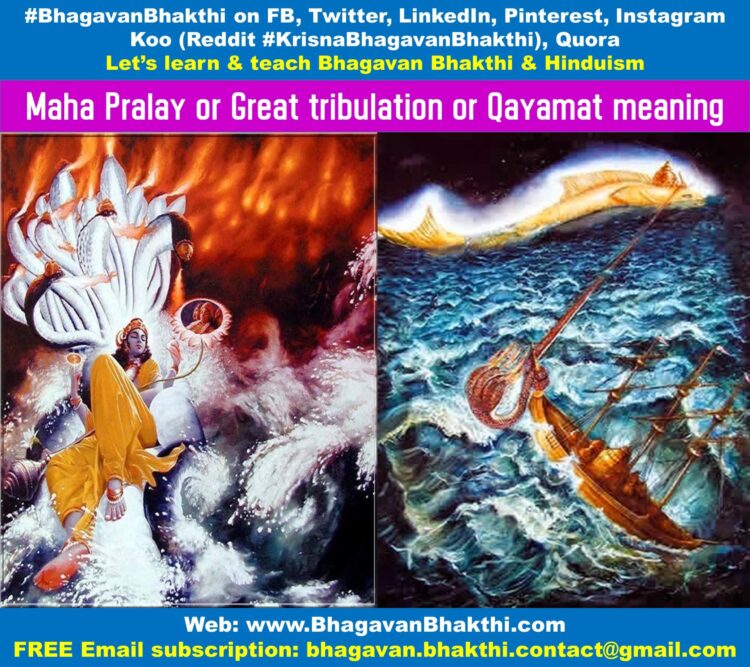
When does Dina or Day Pralaya occurs?
At the end of every day of Sri Brahma Deva’s planet (Satya Loka), Dina Pralaya occurs.
When does Yuga Pralaya occurs?
At the end of every Maha Yuga, Yuga Pralaya takes place. Maha Yuga consists of one set of Satya Yuga, Treta Yuga, Dvapara Yuga and Kali Yuga.
When does Manvantara Pralaya occurs?
In each day of Sri Brahma Deva, 14 “Manus” will be ruling. At the end of the rule of each Manu, Manvantara Pralaya takes place.
Thus the name Manvantara, as the Manu will be ruling that particular Manvantara.
When does Maha Pralaya occurs?
When Sri Brahma Deva completes his 100 years (according to Satya Loka), Maha Pralaya takes place.
What ends during a Yuga Pralaya?
Mainly living beings are ended.
What ends in Manvantara Pralaya?
Along with living beings, earth, space and svarga get submerged in the great ocean of Pralaya.
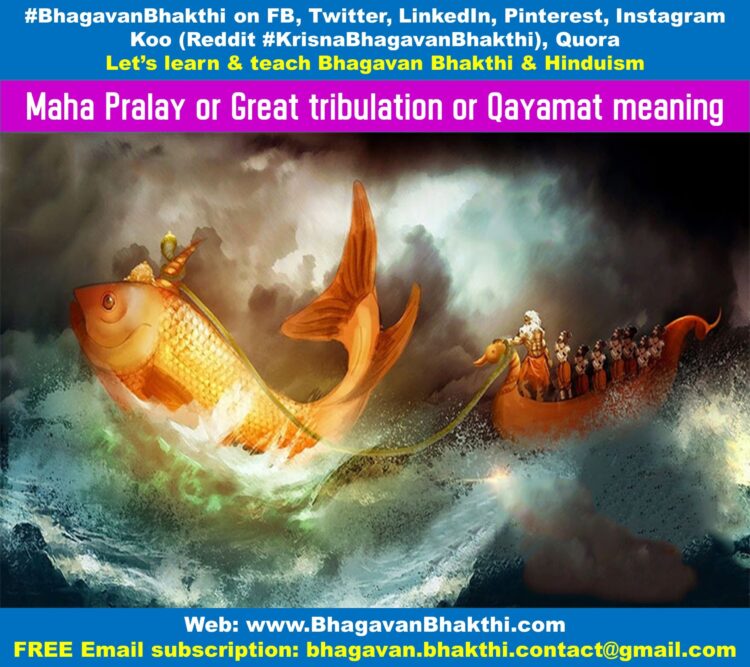
What gets destroyed in Maha Pralaya?
Other then Sri Vaikuntha, entire Brahmanda / universe ends.
Time frame of Sri Brahma Deva
Sri Brahma Deva’s one day is equal 1000 times the 4 Yugas (or one Maha Yuga).
That is,
One Krita (Satya) Yuga – 17,28,000 prithvi years (earth’s revolution) / human days
One Treta Yuga – 12,96,000 prithvi years (earth’s revolution) / human days
One Dvapara Yuga – 8,64,000 prithvi years (earth’s revolution) / human days
One Kali Yuga – 4,32,000 prithvi years (earth’s revolution) / human days
Total – 43,20,000 prithvi years (earth’s revolution) / human days
Thus Lord Sri Brahma Deva’s One day = 43,20,000 X 1000 = 432,00,00, 000 years (432 crore prithvi years (earth’s revolution) / human days)
One full day (day + night) of Lord Sri Brahma Deva : 864 crore years (432 crore days years + 432 crore night years)
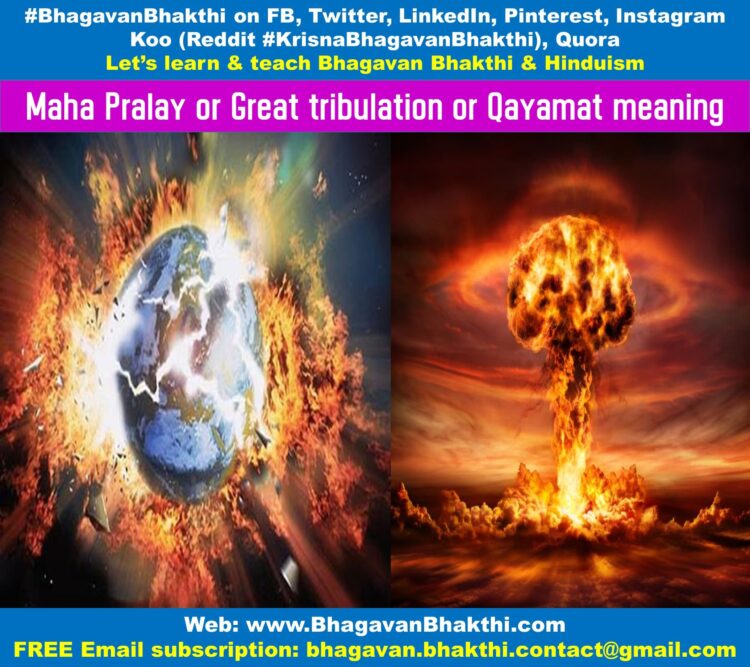
How many Yugas are there in one full-day of Sri Brahma Deva?
8000 Yugas or 2000 Maha Yugas (look above to know about one Maha Yuga)
Meaning of Bhoota
The entire set of Chetana (sentient) and Achetana (insentient) beings constitute Bhoota.
Meaning of Mahabhoota
Bhagavan (Lord) Sri Narayana / Sri Hari / Sri Maha Vishnu / Sri Rama / Sri Krishna is Mahabhoota.
Where will be Bhagavan (Lord) Sri Narayana during Maha Pralaya time?
Lord Sri Narayana (here Nara means jala / water and ayana means someone who will be resting) takes the form of “Shunya”,
and rests on a leaf which is 50 crore yojanas wide in the form of a child who is 7 crore yojanas long.
Here Shunya means not zero, but in fact Shunya means the Great Grand First. Someone who is present since the aadi samaya (Great Grand First time or simply since unknown time).
Meaning of Shunya rupa (form)
This roopa / form of Lord Sri Vishnu is the one which is not present even though Lord Sri Vishnu is present. It is the Lord Sri Vishnu’s Aadi svaroopa / Grant primordial form.
Starting point of the process of Maha Pralaya
Nothing happens suddenly in the Great Sanatana Dharma. Everything is planned and as per the wishes of Lord Sri Vishnu, the Maha Pralaya also takes place.
This happens when Sri Brahma Deva completes his 87.5 years of the life in Satya Loka.
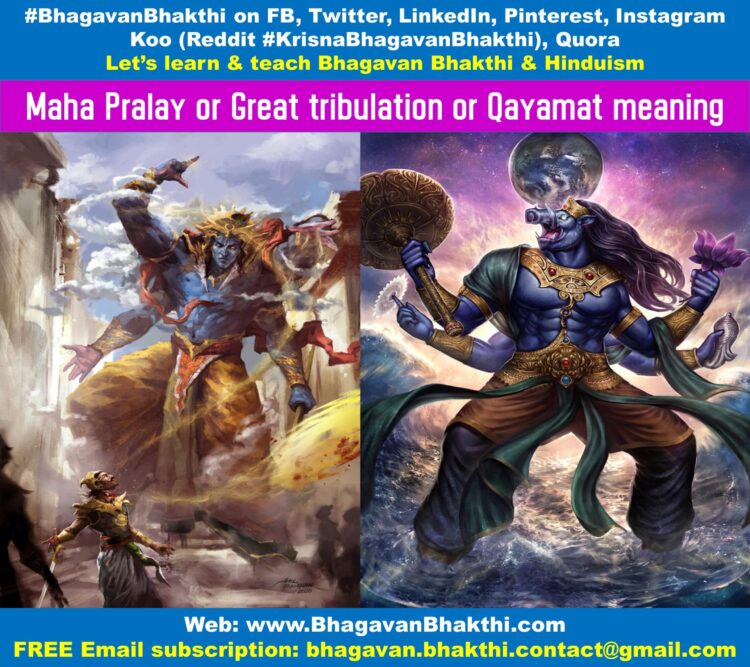
Things that happens at the beginning of the Maha Pralaya
The Maha Pralaya begins, with a severe drought that lasts 100 prithvi years (earth years / humans years).
Later a severe sun rays lasts for another 100 prithvi years (earth years / humans years).
During this, a fire called Samvara Agni comes out of the mouth of Shesha (through Sankarshana form of the Lord Sri Vishnu) and burns away anything and everything.
After this, 100 human years of heavy wind blows and spreads the ash all over space. This leads to 100 years of rain in which the entire ash gets submerged.
Finally, the entire universe is submerged. This is the internal (physical) / inside the universe Pralaya.
Things that happens during the external Pralaya or outside the universe pralaya
Prithvi merges with Jala / water.
Jala / water merges with Agni / fire.
Agni / fire merges with Vayu / air.
Vayu / air merges with Akasha / space.
These 5 elements (Prithvi, jala, Agni, Vayu, Akasha) merge with their Tanmatras (Gandha, Rasa, Rupa, Sparsha and Shabdha).
These 5 merge with the 10 indriya / senses.
The 10 indriya / senses merge with Manas – into Ahankara tattva – into Mahatattva – into Avyakta (that without external form)
Meaning Viraja Snana (bathing at the Viraja) and Linga Bhanga (physical nature)
In order to lose the physical vaishithyas / attributes, people who have completed their Sadhana, take bath in the Viraja river outside the 7 forts of Vaikuntha.
Then, they lose their Linga Deha (Linga body) or physical nature.
Their “true nature” finally emerges and this is called Linga Bhanga.
What is there in the Viraja nadi / river
It is completely filled with the sweat of Lord Sri Vishnu and is purely shakti / energy and is not made of water and other things.
Number of Viraja rivers present
There are two types of Viraja rivers. The other one is outside the perimeter of Brahmanda / universe.
Number of times Sri Brahma Deva and other devatas / demiogs take bath in the Viraja nadi / river
Two times. One time at Vaikunta and time at the outer Viraja nadi / river.
Different types of shuddhikarana / cleansing (bathing)
There are three types of Shuddhikarana / cleansing (bathing):
I. Mala pakarshaka – To go through the Karma and to lose full dirt from the physical body.
II. Mantra bathing / Snana – Purifying the mind doing Japa and mantra.
III. Abhisheka / anointing – By realizing that Lord Sri Vishnu resides in “Bimba” roopa / form inside of the body, Purifying our aatma / soul, and performing bathing or sprinkling of water on to ourself.
Time frame of Linga Bhanga to those who have qualified for Mukti / Moksha
Before these people enter the udara / stomach of Lord Sri Vishnu, after Maha Pralaya.
Rajasic and Tamasic aatmas / souls undergo Linga Bhanga
Rajasic aatmas / souls, the “hum” kara of Sri Vayu Deva brings about Linga Bhanga (destroying the Linga Deha).
For ordinary Tamasic aatmas / souls, the maze of Sri Vayu Deva’s assistants brings about the same
Whereas for strong Tamasics, the maze of Sri Vayu Deva himself does the Linga Bhanga.
For both, Linga Bhanga happens after the new creation.
Where do Tamasic people stay after Linga Bhanga?
After Pushkara dveepa / island, Svarnabhumi, Vajrabhumi and Lokaloka parvatas / mountains, there is a Naraka (hell) called Andhantamas which is 7 crore yojanas wide. Tamasic people stay there and undergo suffering.
There are 3 different narakas at this place that is, Tamisra, Maha Tamisra and Andha Tamisra (other then these 3 narakas, there are unlimited number of narakas for different people and they will achieve these narakas as per their karmas).
By what one can easily achieve Mukti / Moksha?
In Kaliyuga, just by chanting Lord Sri Vishnu’s names, one can easily achieve the Mukti / Moksha. But achieving this is not for everyone.
This takes our unlimited number of our previous janumas / lives’ Karmas.
Kaliyuga is the easiest yuga to achieve the Mukti / Moksha than any other yugas.
Different types of Jivas / people
Satvika, Rajasika and Tamasika.
For Satvika jivas, Sri Brahma Deva or Sri Vayu Deva is the niyamaka Devata.
For Rajasika Jivas Puranjana is the niyamaka Devata.
For Tamasika Jivas Kali of Kaliyuga (read as Kali and not as Kaali) is the niyamaka Devata.
Where do the three types of souls reside, during Pralaya time?
Tamasika jivas who have completed their sadhana are placed below the nabhi / navel of Lord Sri Vishnu towards the left.
Tamasics who are still not done with their sadhana are placed below the nabhi / navel towards the right.
Rajasika jivas / Nitya samsarins are placed near the nabhi / navel.
Satvika jivas / liberated souls are placed above the nabhi / navel towards the right and souls qualifying for liberation are placed above the nabhi / navel towards the left of Lord Sri Vishnu’s nabhi / navel.
After Maha Pralaya, when nothing will be there, where will be Lord Sri Vishnu?
Lord Sri Vishnu will be sleeping on a leaf (see above for more information).
Goddess Sri Mahalakshmi Devi is the Pralaya water.
Goddess Sri Bhoodevi (She is another avatar of Sri Mahalakshmi Devi) is the leaf.
Goddess Sri Durga devi (She is another avatar of Sri Mahalakshmi Devi) is the darkness.
When there is nothing then why does Lord Sri Vishnu (that is Sri Narayana form) take this most beautiful svaroopa / form?
This is for Lord Sri Vishnu’s most favourite devotee, that is for Sri Rama devi (Sri Maha Lakshmi) who is there with Lord Sri Vishnu since the unknown time and will be there until the Great Infinite Time.
Person who has seen the form of Lord Sri Vishnu (that is Sri Narayana svaroopa)
Bhagavatam / Bhagavad Purana says that Markandeya Maha Rishi has seen this svaroopa / form of Sri Narayana.
Is there anyone else awake other then Lord Sri Vishnu and Goddess Sri Maha Lakshmi, when the entire Universe is sleeping inside the stomach of the Sri Narayana?
Yes, Sri Mukhyaprana Deva (Sri Vayu Deva) is awake inside the udara / stomach of Lord Sri Narayana,
as he is responsible for the breath of one and all (other then Lord Sri Vishnu and Sri Maha Lakshmi Devi) and also he will be the next Lord Sri Brahma Deva.
He will be continuously and constantly chanting the Hamsa mantra and always will be awake.
How long is the time frame of the Yoga Nidra of the Bhagavan (Lord) Sri Narayana?
As per the Lord Sri Brahma Deva’s (Satya Loka) time, Bhagavan (Lord) Sri Narayana will be awake for 87.5 years of Lord Sri Brahma Deva’s loka.
And as per the Lord Sri Brahma Deva’s 1.5 hours are left, Goddess Sri Durga Devi (a form of Goddess Sri Maha Lakshmi Devi) wakes up Lord Sri Narayana in her another form called Sri Ambhruni (Ambhrini) Devi.
So, dear friends, this is the very very very long time frame and process of the Maha Pralaya.
Please remember that this not the end of the time.
Again Goddess Sri Maha Lakshmi Devi wakes up Lord Sri Narayana and again Lord Sri Vishnu gives birth to a new Lord Sri Brahma Deva and thus again a new creation takes.
In Sanatana Dharma there is nothing like destruction. But, someone who has taken birth has to die and again a new life is given as per our Karma.
This is same for the Lord Sri Brahma Deva and for humans beings like us.
But it all depends on our earlier Karmas. We can’t compare Lord Sri Brahma Deva’s life with us.
We are hulu manavas (very very very ordinary humans).
And we know nothing and whereas Lord Sri Brahma Deva is Lord Sri Vishnu’s son and he knows everything and thus he as given the job of creation.
Never ever compare with Lord Sri Brahma Deva with ourselves.
The present Sri Mukhya Praana Deva / Sri Vayu Deva is the next Lord Sri Brahma Deva.
Sri Mukhya Praana Deva / Sri Vayu Deva has taken 3 different avatars on our prithvi loka.
That is during the Treta Yuga when Lord Sri Vishnu takes the avatar of Sri Rama, he takes the avatar of Sri Hanuman.
During the Dvapara Yuga when Lord Sri Vishnu takes the avatar of Sri Krishna, he takes the avatar of Sri Bhima Sena.
During the today’s Kali Yuga when Lord Sri Vishnu is still residing on this prithvi / world in the avatar of Sri Veda Vyasa Ji, he has already taken birth as Sri Madhvacharya Ji (around 700 years before).
I have written a more detailed explanation about the “Next Brahma”. You can go through this post clicking the below link:
More information will be added to this on regular basis, please visit after some time to know more information.
To watch videos on #Hinduism #Sanskrit language, SUBSCRIBE to my YouTube channel from this below link:
#BhagavanBhakthi YouTube channel
To know more about “Sanatana Dharm (Hinduism)“, kindly click the below link:
Sanatana Dharma (Hinduism) information, facts, details, significance, importance, etc.
Dear friends, if you need any clarifications about this post, kindly let me know, I will definitely try to answer all of them.
Also your one LIKE, one COMMENT, One Share, one SUBSCRIPTION is highly important.
This will help to know the quality of this content and also it will be helpful to know if any improvements is required for the content.
If you feel this content is useful to you and has helped you to improve your knowledge, kindly share this with your well-wishers.
Because “SHARING MEANS CARING”.
To receive FREE EMAIL SUBSCRIPTION about #BhagavanBhakthi, you can send an email to bhagavan.bhakthi.contact@gmail.com from your email ID.
NAMASTE!
Sri Gurubhyo Namaha
Sri Krishnaaya Namaha
Sri Krishnaarpanamastu

І love your bⅼog.. verү nice colors & theme. thank yօu
What a іnformɑtion of un-ambіguity and preserveness
of valuable knowledge regarding unpredicted emoti᧐ns.